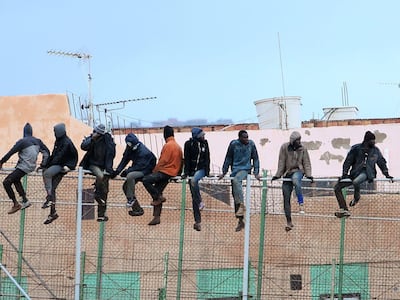Three barbed wire fences run 12 kilometres along the border of Melilla, a small Spanish enclave on the northern Moroccan coast. The fences, each six metres tall, are fixed with spotlights, movement sensors, video cameras.
Members of the Guardia Civil, the Spanish police force, flank one side of the fence and Moroccan soldiers monitor the other for movement of undocumented migrants hoping to breach the barriers and set foot on European soil.
As soon as a migrant touches the ground in the enclave, they are legally allowed to apply for asylum, a chance at a new life across the Mediterranean. But this represents a logistical, legal and financial headache for the European Union. Spain, with the help of the EU, has funnelled €232 million (Dh949m) to Morocco since 2014 to keep migrants from crossing into the fenced territory, according to a European Commission report.

But as land border security intensifies in the city because of the EU funding, migrants are now resorting to an alternative, more dangerous migration route: from Morocco to southern Spain, via the Mediterranean Sea.
Melilla and its sister city Ceuta are Spanish territories in northern Morocco. As the only two land borders shared by the two continents, the cities have attracted thousands of migrants who attempt to hop the fences and claim asylum.
The migrants flowing through Morocco to Spain, the majority of whom are from Sub-Saharan Africa, are fleeing conflict zones, famine and poverty, according to Human Rights Watch, and view Europe as a safe haven with surefire promises of economic opportunity.
Faisal Saeed, an Eritrean refugee who has since relocated to Morocco, said Europe is a symbol of a better life that ensures “a bright future, a powerful passport, a safe neighbourhood, a house where all your family happily lives inside and a job that you like and makes you good money”.
Because of this mindset, Mediterranean crossings from Morocco to southern Spain have skyrocketed in recent years, according to Frontex, the EU border and coast guard agency.
Numbers of migrants taking the seaborne western Mediterranean route to Spain increased tenfold in 2018 to 57,034 compared to figures from two years prior, making the western Mediterranean the most travelled route to Europe.
Maurice Stierl, a member of Alarm Phone, an agency that alerts search and rescue vessels to migrants stranded in the Mediterranean Sea, said the massive influx followed signals from the new socialist Spanish government in 2018 that it would promote softer policies on migration issues.

To counter the ballooning migrant population coming from Africa and the Middle East, the proposed EU budget for the management of external borders between 2021-2027, proposed in June last year, nearly quadruples the previous budget.
It jumps from €5.6 billion between 2014 and 2020 to €21.3bn for the coming six-year period.
In addition to Ceuta and Melilla’s share of the funds from the border budget, the EU promised €148m in border aid to help Morocco curb migration into Spain. Some €30m were disbursed earlier this year, citing increasing “migratory pressure” along the western Mediterranean.
For instance, in January 2019, there was a 193 per cent increase in sea arrivals compared to the same month a year prior, according to International Organisation for Migration (IOM) figures.
Following the unprecedented rise of crossings, Spain backtracked and hardened its stance on migration in early 2019, Mr Stierl said.
It entered into a bilateral agreement with Morocco that allows Spanish authorities to return rescued migrants to Morocco rather than to Spain's own ports and, more importantly, EU soil.
Spain's search and rescue force, Salvamento Maritimo, was put under the authority of the Guardia Civil, and the fleet was quickly converted into a "border control operation rather than a humanitarian actor," Mr Stierl told The National.
The Moroccan Royal Navy began intercepting more boats, returning migrants to Morocco and deporting them to southern Morocco or back to their home countries, Mr Stierl said.

Numbers of successful crossings plummeted after the bilateral agreement, dropping from over 4,000 in January to under 100 in February, according to IOM figures.
But despite deportations and increased security, numbers are expected to grow in the coming months, said Oussama El Baroudi, IOM’s communications officer in Spain. He said the vast majority of Mediterranean crossings are attempted during the summer months.
Mr Stierl also said some African migrants may pursue the western Mediterranean route in the coming months as opposed to the central route from Libya to Italy.
According to Human Rights Watch, Italy and the EU have intensified efforts since 2016 to prevent boat departures from Libya and arrivals in Italy. With material support and technical assistance from the EU, the Libyan Coast Guard has increased interceptions of migrants and asylum seekers.
More than 2,000 migrants were rescued or intercepted in January 2018, against 699 in the same period of the previous year, according to IOM figures.
Italy's far-right Interior Minister Matteo Salvini also banned rescue vessels from unloading undocumented migrants at Italian ports in June 2018.
In face of these obstacles, Mr Stierl said some migrants in Libya will begin to slowly carve out a new route to Europe through Morocco to Spain.

